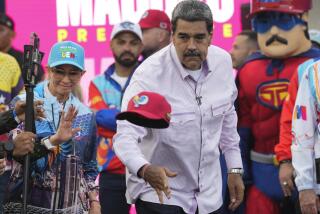Bolivia Cocaine Output Soars : Andean nation has long been a major grower of coca leaves. Now, it’s a major producer of market-ready powder.
- Share via
LA PAZ, Bolivia — With Colombia feeling the impact of an international anti-drug war, attention has shifted to Bolivia, which is becoming a major producer of cocaine.
But the authorities here are moving to meet the challenge, expanding the intelligence effort and preparing to throw new military resources into the fight.
As a grower of coca leaves, the raw material of cocaine, Bolivia ranks No. 2 in the world after neighboring Peru. Until two years ago, almost all Bolivian cocaine was sent to Colombia--either as crude paste or as semi-refined base--for final refining. But in recent months, officials say, production here of market-ready cocaine in powder form has reached significant levels.
Gonzalo Torrico, the Bolivian Interior Ministry official in charge of narcotics policy, told a reporter that powder has accounted for at least half of the nine tons of cocaine seized by Bolivian authorities this year.
Background
Bolivians apparently began refining cocaine because they felt they were not getting a fair share of the huge profits that Colombians were reaping in the United States. Then, when the drug war in Colombia began cutting seriously into the traffic, Bolivian refining was stepped up another notch.
Torrico said that “sophisticated and modern laboratories” have sprung up in the remote northern provinces close to the border with Peru and Brazil.
He added that much Bolivian cocaine is bypassing Colombia altogether, going out through Brazil, Argentina and Chile.
An officer of the U.S. Drug Enforcement Administration working in Bolivia said more and more Colombian traffickers are moving into Bolivia.
“They get squeezed one place, they’re going to look for another,” he said. “Bolivia is pretty accessible to them because they have been doing business here for a long time.”
Officials are worried that the Colombians are bringing with them their violent way of doing business. A Colombian nabbed in a recent raid, in which a Bolivian police lieutenant was killed, was armed with a .45-caliber submachine gun.
U.S. Response
The staff of the DEA intelligence center at the U. S. Embassy has been increased to seven people.
For the first time, one of the DEA officers said, the center is computerizing information on smuggling routes, laboratory sites and organizations and individuals involved in the traffic. The information is used in joint operations by Bolivian police and DEA agents.
“Lab seizures have increased dramatically,” the DEA officer said. “In the last six months, we have probably got 12 major paste buyers.”
Latin Response
In May, President Jaime Paz Zamora agreed to throw the Bolivian army into the campaign. U.S. military personnel are expected to train two Bolivian “strike battalions” of 450 people each this year and two more battalions next year.
According to informed sources, the strike battalions will be used for operations in remote border areas that the police have difficulty controlling. One source said they will work with the police in areas “where we would suspect there might be heavy resistance by traffickers, or towns where traffickers are in full control.”
To control the airspace, which the drug smugglers use almost unimpeded, U.S. officials want to renovate seven Bolivian PC-7 turboprop trainers this year and seven more next year. Bolivia has 18 of the Swiss-built planes, but only six are operating at present.
Up to 10 of Bolivia’s 24 T-33 trainers are to be fitted with modern electronic equipment for anti-drug work, according to the U.S. plan.
More to Read
Sign up for Essential California
The most important California stories and recommendations in your inbox every morning.
You may occasionally receive promotional content from the Los Angeles Times.













